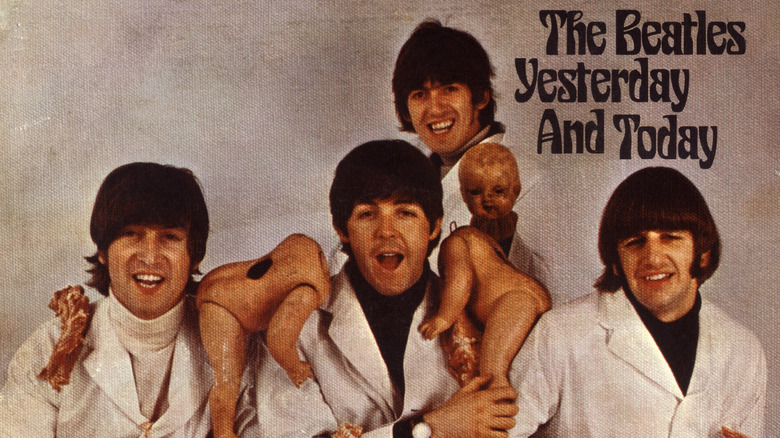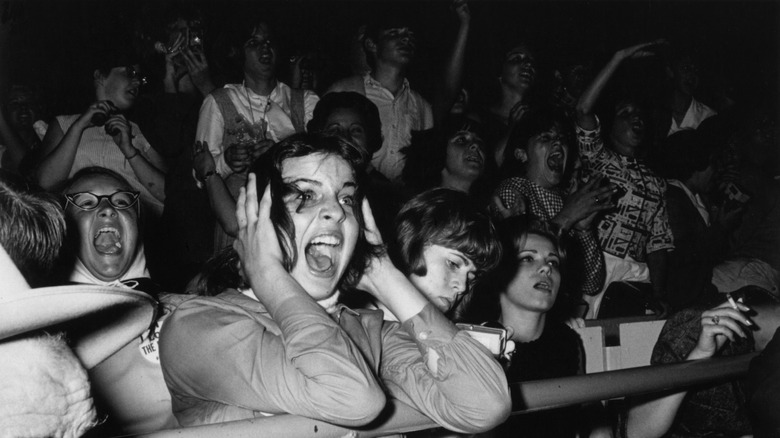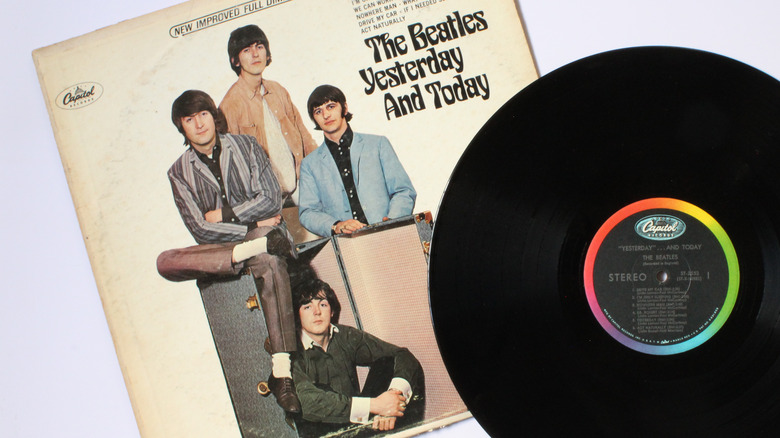The Truth About The Beatles' Yesterday And Today Album Art
The most controversial cover of the Beatles ever is probably "Yesterday and Today." As Rolling Stone reports, a 26-year old photographer was the person behind the idea. Photographer Robert Whitaker had previously photographed John Lennon, publishing the prints in 1965, during the height of Beatlemania. The quirky photos featured Lennon with a flower on his eye (via the National Portrait Gallery). But by 1966, Whitaker was growing frustrated with the limitations that stardom had put on his subjects, saying, "I got fed up with taking squeaky-clean pictures of the Beatles." (via Rolling Stone).
So Whitaker posed the four men with chopped-up dolls, covered in dirt and pieces of meat (via Robert Whitaker Photography). The cover became known as the "butcher" cover, and people were immediately offended by it. It didn't help that just before the scandalous cover was revealed, John Lennon had said that the Beatles were "more popular than Jesus," as Brittanica reports. He later apologized for the remarks.
Blasphemy, conspiracies, and Beatlemania
Explaining the photo, Whitaker said, "All over the world I'd watched people worshiping like gods, four Beatles. To me, they were just stock standard normal people. But this emotion that fans poured on them made me wonder where Christianity was heading" (via Rolling Stone).
Album executives were absolutely furious with the album art. But after a conversation with Paul McCartney, who advocated for its release, the label went ahead put the album out to the public.
Some fans wondered if there was a hidden meaning behind the photoshoot (via Rolling Stone). Apparently, the "Yesterday and Today" album was put out quickly and padded out with extra songs. So some fans interpreted the cut-up meat cover to symbolize that the album was thrown together sloppily, or wondered if the band was giving the middle finger to their label. Whitaker says his intention was to satirize the hype around pop stars and Beatlemania.
Real meaning — and the aftermath
Yet the real meaning, according to Paul McCartney, was that it was a commentary on the Vietnam War -– or at least, that's what he told the president of the label, Alan Livingston. According to Rolling Stone, McCartney and Lennon both pushed hard for the album art to remain as Whitaker had created it. Lennon later said, "There we were, supposed to be sort of angels. I wanted to show that we were really aware of life."
They ran into trouble almost immediately. After Capitol Records printed more than 60,000 copies, most retailers wouldn't touch the album and refused to put it on their shelves. It was considered too gory and distasteful. As Brittanica reports, dozens of radio hosts smashed the albums, while others held record-burning events. John Lennon defended the artwork, saying, "If the public can accept something as cruel as the war, they can accept this cover."
The backlash was so bad that reportedly as many as 50,000 copies were thrown out and buried in a landfill. Some stores simply covered the front of the album with a cover sleeve. According to Goldmine, subsequent "Yesterday And Today" albums were printed with entirely different cover art – referred to as the "trunk cover." Because there are so few copies of the "butcher cover" now, the remaining ones are extremely rare collector's items.


